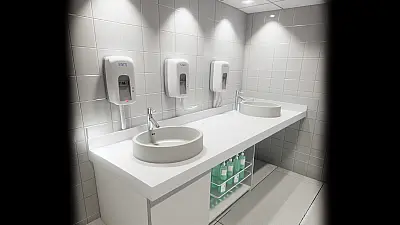GARRISON, ND - Federal inspectors found that nursing assistants and nurses at Garrison Memorial Hospital Nursing Facility repeatedly failed to sanitize patient lift equipment between residents, violating basic infection control protocols that protect vulnerable residents from potential disease transmission.

Critical Infection Control Breakdown
The February 27 inspection revealed a systematic failure in the facility's infection prevention program, with staff observed on multiple occasions moving mechanical lift devices directly from one resident to another without proper disinfection. This pattern of non-compliance occurred despite the facility having a clear policy requiring disinfection of all multi-use medical devices between patient uses.
Over the course of just one afternoon, inspectors documented three separate incidents where nursing staff failed to follow proper sanitization procedures. In each case, stand lifts used to transfer residents from toilets to wheelchairs were immediately moved to serve other residents or placed in storage without any cleaning.
During one incident at 1:40 p.m., a certified nursing aide transferred a resident from the toilet using a stand lift, then failed to sanitize the equipment afterward. When questioned about sanitization protocols, the aide incorrectly stated that "housekeeping does that," demonstrating a fundamental misunderstanding of infection control responsibilities.
Medical Significance of Equipment Disinfection
Mechanical lift devices represent a significant infection transmission risk in healthcare settings because they come into direct contact with residents during intimate care activities like toileting. These devices can harbor dangerous pathogens including antibiotic-resistant bacteria, viruses, and fungi that cause healthcare-associated infections.
When lift equipment moves between residents without proper disinfection, it creates a direct pathway for cross-contamination. This risk becomes particularly acute in nursing home environments where residents frequently have compromised immune systems, chronic wounds, or medical devices that increase their susceptibility to infections.
The failure to sanitize equipment between uses violates fundamental principles of infection prevention that have been standard practice in healthcare for decades. Proper disinfection protocols require cleaning visible soil first, then applying EPA-approved disinfectants that remain in contact with surfaces for specified time periods to effectively kill pathogens.
Confusion Over Cleaning Responsibilities
The inspection revealed significant confusion among staff regarding who bears responsibility for equipment sanitization. While housekeeping maintains a schedule to clean lifts twice monthly, this deep cleaning regimen does not replace the requirement for immediate disinfection after each resident use.
An administrative staff member acknowledged this distinction during interviews, confirming that "staff clean them after each use" in addition to the scheduled housekeeping maintenance. However, the documented observations showed a clear disconnect between policy expectations and actual practice on the nursing units.
When questioned by inspectors, the facility's administrative nurse confirmed that staff should sanitize lifts between resident uses, indicating that proper protocols existed but were not being consistently followed by frontline caregivers.
Industry Standards and Best Practices
Current Centers for Disease Control and Prevention guidelines establish that all reusable medical equipment must undergo appropriate cleaning and disinfection between patients. For mechanical lifts, this typically involves removing visible contamination followed by application of hospital-grade disinfectants.
The facility's own policy, dating to February 2011, specifically identifies mechanical lift devices among the multi-use equipment requiring disinfection between residents. This policy aligns with established healthcare standards but appears to lack adequate implementation and staff training components.
Healthcare facilities typically address this challenge through regular competency assessments, clear assignment of responsibilities, and readily available cleaning supplies at the point of care. Some facilities also implement color-coded systems or checklists to ensure staff complete required disinfection steps.
Impact on Resident Safety
The documented failures create unnecessary infection risks for some of the healthcare system's most vulnerable patients. Nursing home residents often face multiple health challenges that compromise their ability to fight off infections, making prevention strategies critically important.
Healthcare-associated infections in long-term care settings can lead to serious complications including sepsis, pneumonia, and urinary tract infections. These conditions frequently require hospitalization and can significantly impact quality of life for elderly residents.
Additional Issues Identified
The inspection focused specifically on infection control related to mechanical lift equipment, representing one component of the facility's broader infection prevention program. The violations were classified as having potential for minimal harm, suggesting inspectors found the issues before they resulted in documented resident infections.
The facility's infection control program includes other multi-use devices beyond mechanical lifts, though the inspection narrative did not detail compliance with sanitization protocols for other equipment categories.
Full Inspection Report
The details above represent a summary of key findings. View the complete inspection report for Garrison Mem Hosp Nsg Fac from 2025-02-27 including all violations, facility responses, and corrective action plans.
💬 Join the Discussion
Comments are moderated. Please keep discussions respectful and relevant to nursing home care quality.